Impact of Elasticity on TESCO's Business Decisions: An Analysis
VerifiedAdded on 2020/10/22
|11
|3046
|407
Report
AI Summary
This report provides an economic analysis of the elasticity of demand, focusing on its application to TESCO, a multinational retailer. The report begins by defining elasticity of demand and its various elements: price elasticity, cross-price elasticity, and income elasticity. It explains how these elements influence consumer behavior and the demand for goods and services. The analysis then transitions to how TESCO can leverage elasticity to make informed business decisions. The report examines how TESCO uses price elasticity to determine pricing strategies for different product categories, considering factors like the availability of substitutes and consumer sensitivity. It explores how cross-price elasticity impacts TESCO's decisions regarding substitute and complementary products, and finally, how income elasticity influences TESCO's understanding of consumer spending habits and product demand. The report provides practical examples of how TESCO applies these concepts to optimize its marketing strategies, manage product pricing, and navigate the competitive retail landscape. The analysis is based on real-world examples from TESCO, illustrating the practical application of economic principles in a business context.
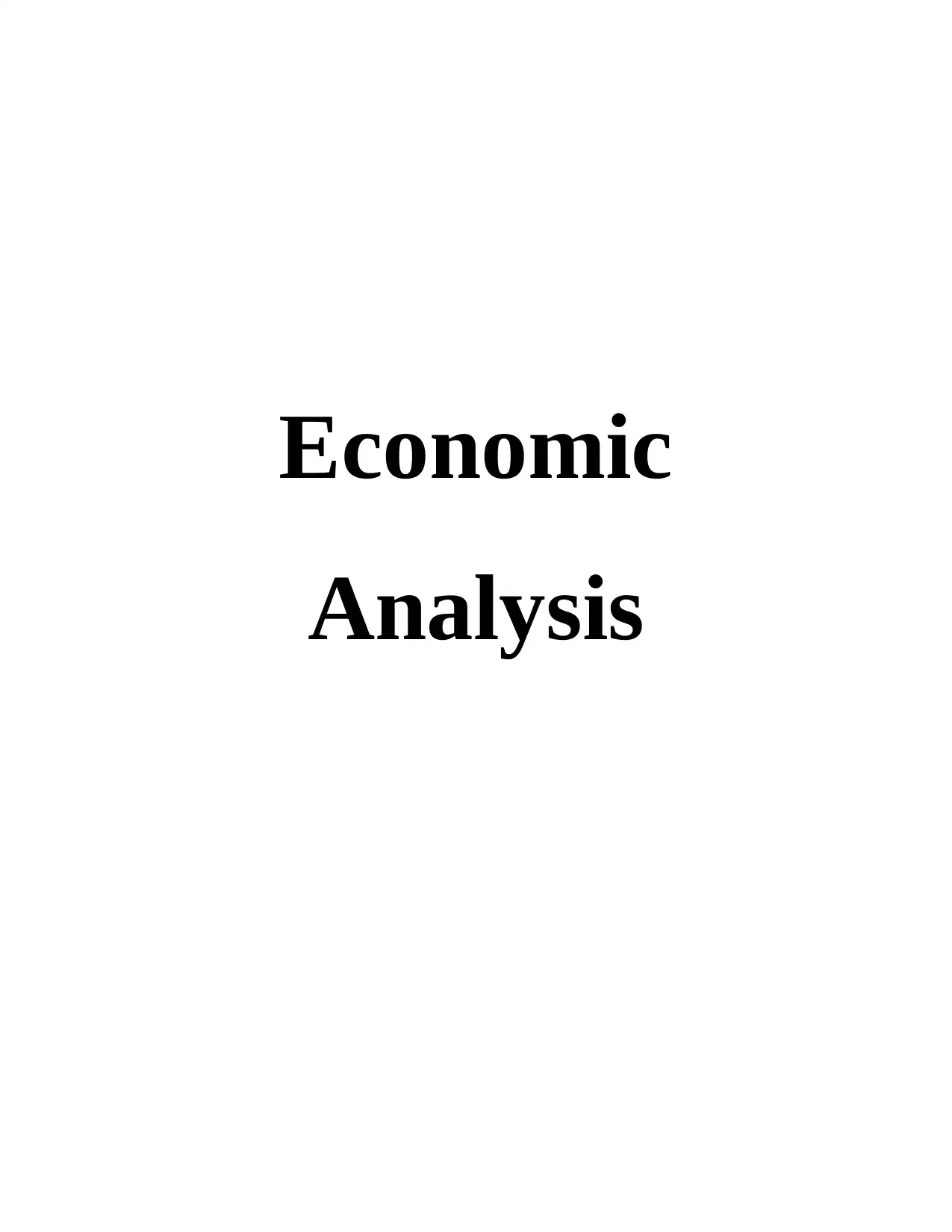
Economic
Analysis
Analysis
Paraphrase This Document
Need a fresh take? Get an instant paraphrase of this document with our AI Paraphraser
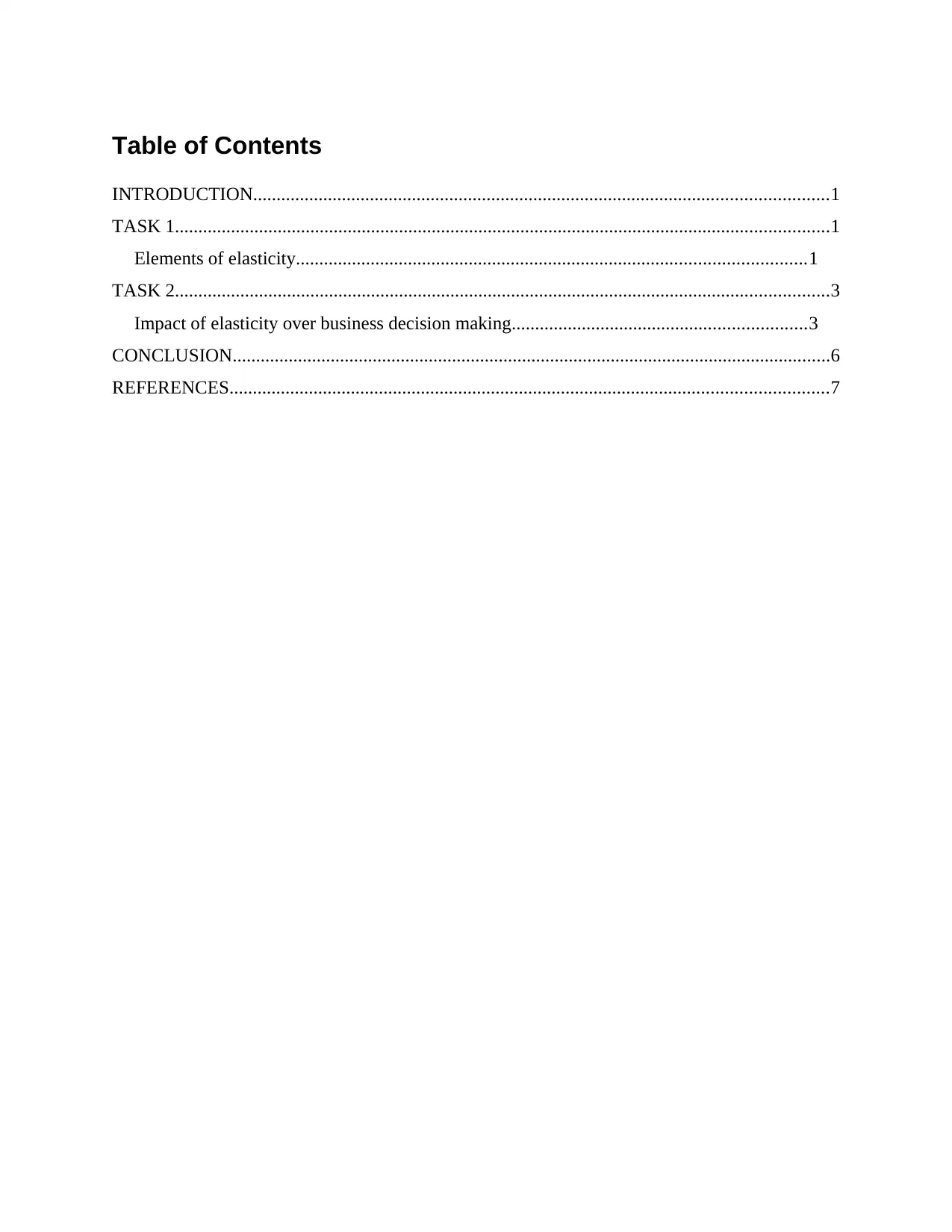
Table of Contents
INTRODUCTION...........................................................................................................................1
TASK 1............................................................................................................................................1
Elements of elasticity.............................................................................................................1
TASK 2............................................................................................................................................3
Impact of elasticity over business decision making...............................................................3
CONCLUSION................................................................................................................................6
REFERENCES................................................................................................................................7
INTRODUCTION...........................................................................................................................1
TASK 1............................................................................................................................................1
Elements of elasticity.............................................................................................................1
TASK 2............................................................................................................................................3
Impact of elasticity over business decision making...............................................................3
CONCLUSION................................................................................................................................6
REFERENCES................................................................................................................................7
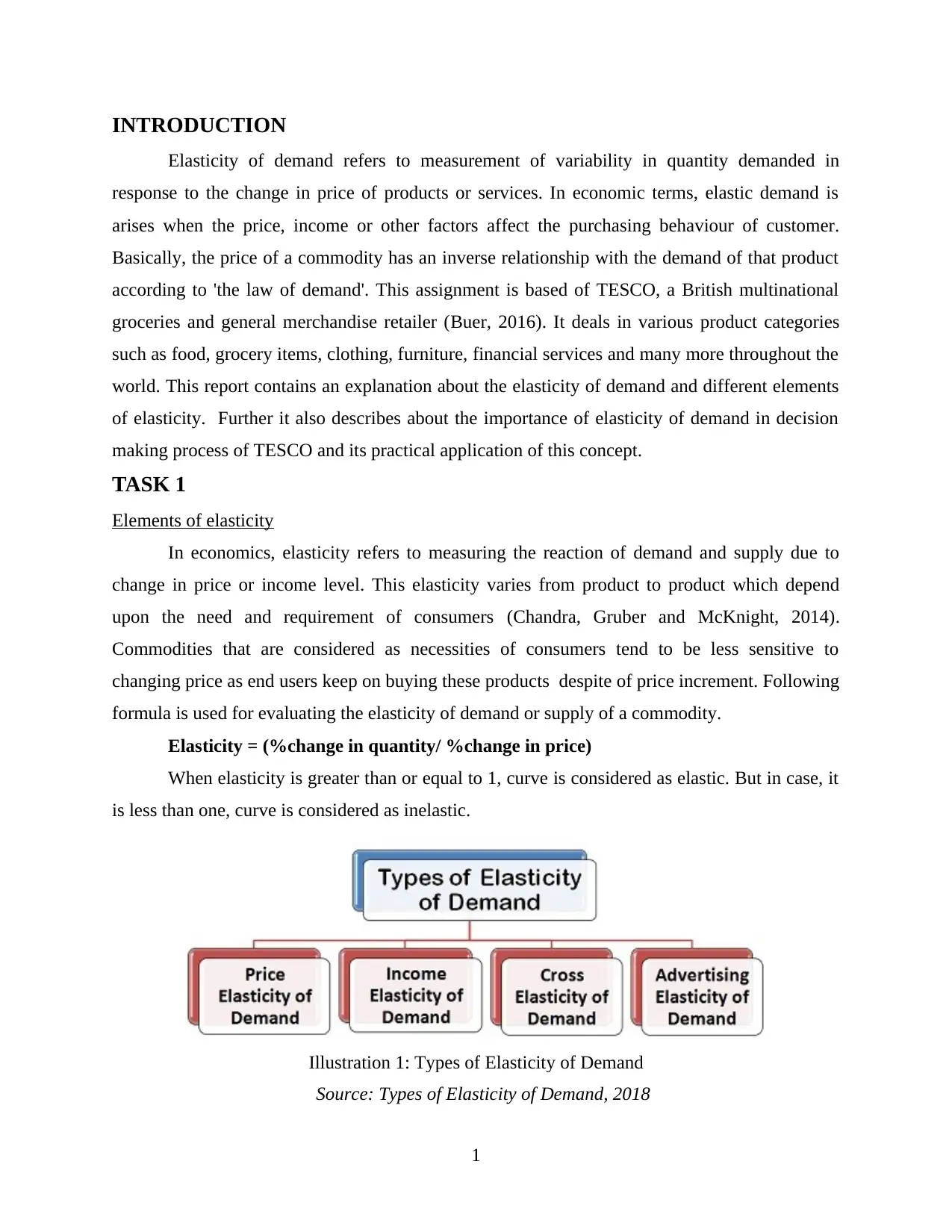
INTRODUCTION
Elasticity of demand refers to measurement of variability in quantity demanded in
response to the change in price of products or services. In economic terms, elastic demand is
arises when the price, income or other factors affect the purchasing behaviour of customer.
Basically, the price of a commodity has an inverse relationship with the demand of that product
according to 'the law of demand'. This assignment is based of TESCO, a British multinational
groceries and general merchandise retailer (Buer, 2016). It deals in various product categories
such as food, grocery items, clothing, furniture, financial services and many more throughout the
world. This report contains an explanation about the elasticity of demand and different elements
of elasticity. Further it also describes about the importance of elasticity of demand in decision
making process of TESCO and its practical application of this concept.
TASK 1
Elements of elasticity
In economics, elasticity refers to measuring the reaction of demand and supply due to
change in price or income level. This elasticity varies from product to product which depend
upon the need and requirement of consumers (Chandra, Gruber and McKnight, 2014).
Commodities that are considered as necessities of consumers tend to be less sensitive to
changing price as end users keep on buying these products despite of price increment. Following
formula is used for evaluating the elasticity of demand or supply of a commodity.
Elasticity = (%change in quantity/ %change in price)
When elasticity is greater than or equal to 1, curve is considered as elastic. But in case, it
is less than one, curve is considered as inelastic.
Source: Types of Elasticity of Demand, 2018
1
Illustration 1: Types of Elasticity of Demand
Elasticity of demand refers to measurement of variability in quantity demanded in
response to the change in price of products or services. In economic terms, elastic demand is
arises when the price, income or other factors affect the purchasing behaviour of customer.
Basically, the price of a commodity has an inverse relationship with the demand of that product
according to 'the law of demand'. This assignment is based of TESCO, a British multinational
groceries and general merchandise retailer (Buer, 2016). It deals in various product categories
such as food, grocery items, clothing, furniture, financial services and many more throughout the
world. This report contains an explanation about the elasticity of demand and different elements
of elasticity. Further it also describes about the importance of elasticity of demand in decision
making process of TESCO and its practical application of this concept.
TASK 1
Elements of elasticity
In economics, elasticity refers to measuring the reaction of demand and supply due to
change in price or income level. This elasticity varies from product to product which depend
upon the need and requirement of consumers (Chandra, Gruber and McKnight, 2014).
Commodities that are considered as necessities of consumers tend to be less sensitive to
changing price as end users keep on buying these products despite of price increment. Following
formula is used for evaluating the elasticity of demand or supply of a commodity.
Elasticity = (%change in quantity/ %change in price)
When elasticity is greater than or equal to 1, curve is considered as elastic. But in case, it
is less than one, curve is considered as inelastic.
Source: Types of Elasticity of Demand, 2018
1
Illustration 1: Types of Elasticity of Demand
⊘ This is a preview!⊘
Do you want full access?
Subscribe today to unlock all pages.

Trusted by 1+ million students worldwide
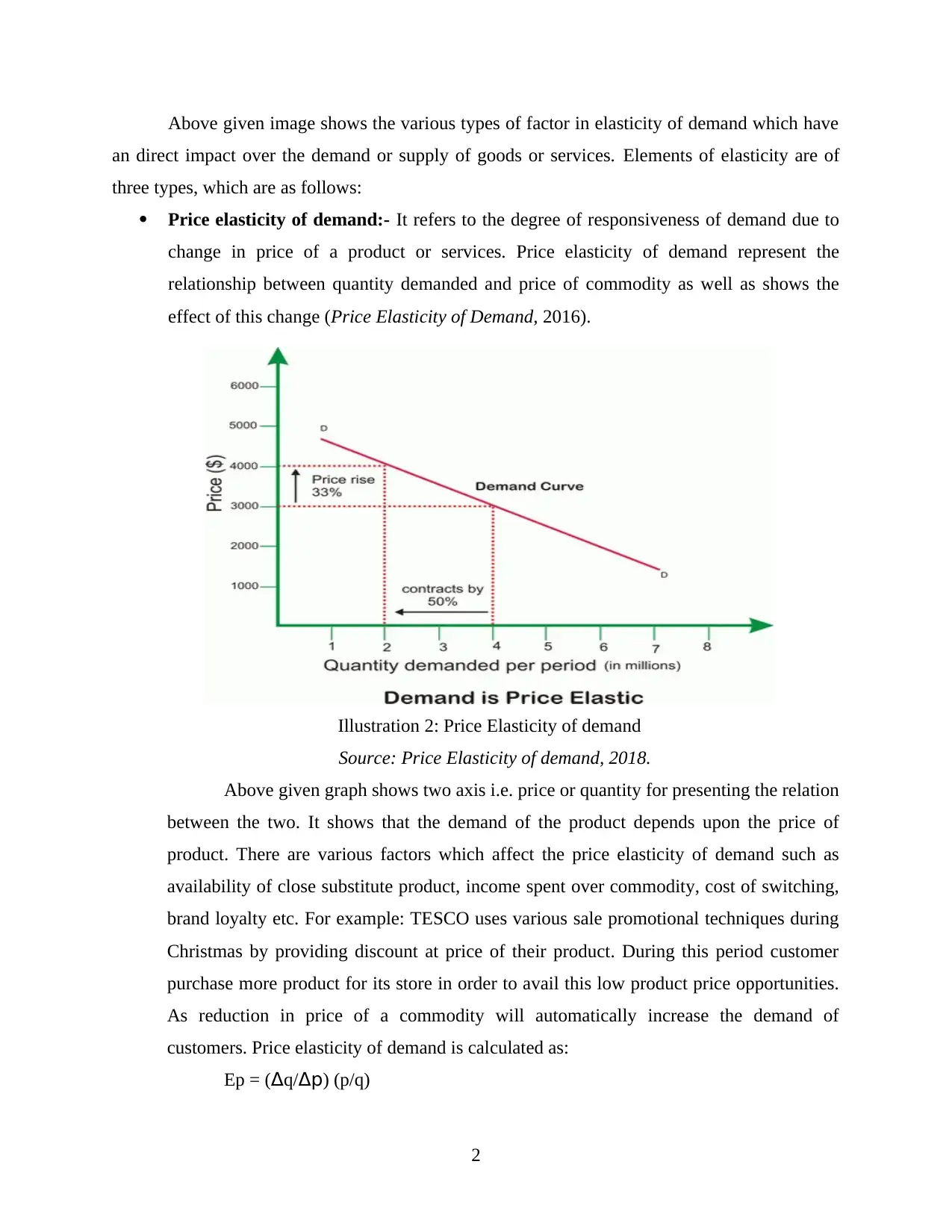
Above given image shows the various types of factor in elasticity of demand which have
an direct impact over the demand or supply of goods or services. Elements of elasticity are of
three types, which are as follows:
Price elasticity of demand:- It refers to the degree of responsiveness of demand due to
change in price of a product or services. Price elasticity of demand represent the
relationship between quantity demanded and price of commodity as well as shows the
effect of this change (Price Elasticity of Demand, 2016).
Source: Price Elasticity of demand, 2018.
Above given graph shows two axis i.e. price or quantity for presenting the relation
between the two. It shows that the demand of the product depends upon the price of
product. There are various factors which affect the price elasticity of demand such as
availability of close substitute product, income spent over commodity, cost of switching,
brand loyalty etc. For example: TESCO uses various sale promotional techniques during
Christmas by providing discount at price of their product. During this period customer
purchase more product for its store in order to avail this low product price opportunities.
As reduction in price of a commodity will automatically increase the demand of
customers. Price elasticity of demand is calculated as:
Ep = (Δq/Δp) (p/q)
2
Illustration 2: Price Elasticity of demand
an direct impact over the demand or supply of goods or services. Elements of elasticity are of
three types, which are as follows:
Price elasticity of demand:- It refers to the degree of responsiveness of demand due to
change in price of a product or services. Price elasticity of demand represent the
relationship between quantity demanded and price of commodity as well as shows the
effect of this change (Price Elasticity of Demand, 2016).
Source: Price Elasticity of demand, 2018.
Above given graph shows two axis i.e. price or quantity for presenting the relation
between the two. It shows that the demand of the product depends upon the price of
product. There are various factors which affect the price elasticity of demand such as
availability of close substitute product, income spent over commodity, cost of switching,
brand loyalty etc. For example: TESCO uses various sale promotional techniques during
Christmas by providing discount at price of their product. During this period customer
purchase more product for its store in order to avail this low product price opportunities.
As reduction in price of a commodity will automatically increase the demand of
customers. Price elasticity of demand is calculated as:
Ep = (Δq/Δp) (p/q)
2
Illustration 2: Price Elasticity of demand
Paraphrase This Document
Need a fresh take? Get an instant paraphrase of this document with our AI Paraphraser
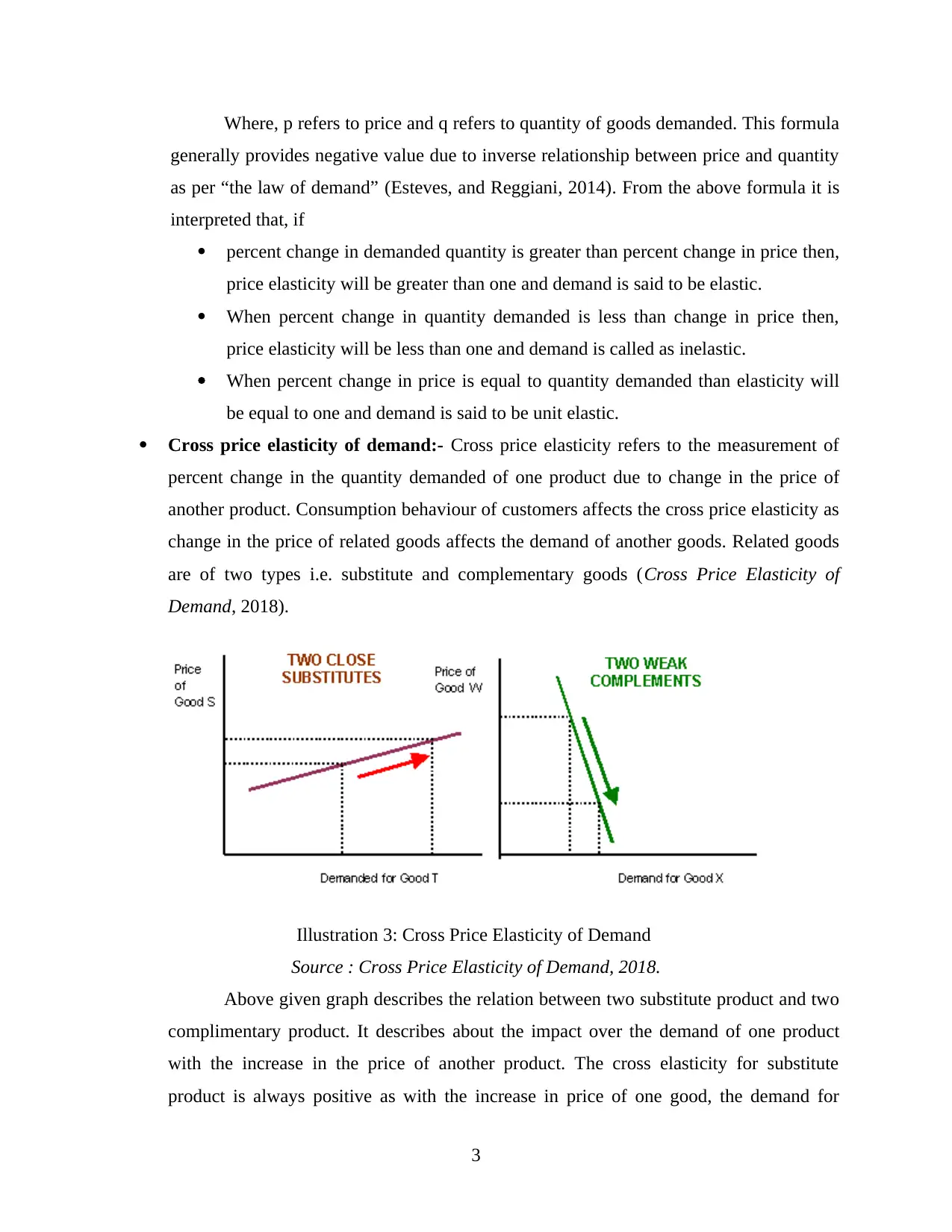
Where, p refers to price and q refers to quantity of goods demanded. This formula
generally provides negative value due to inverse relationship between price and quantity
as per “the law of demand” (Esteves, and Reggiani, 2014). From the above formula it is
interpreted that, if
percent change in demanded quantity is greater than percent change in price then,
price elasticity will be greater than one and demand is said to be elastic.
When percent change in quantity demanded is less than change in price then,
price elasticity will be less than one and demand is called as inelastic.
When percent change in price is equal to quantity demanded than elasticity will
be equal to one and demand is said to be unit elastic.
Cross price elasticity of demand:- Cross price elasticity refers to the measurement of
percent change in the quantity demanded of one product due to change in the price of
another product. Consumption behaviour of customers affects the cross price elasticity as
change in the price of related goods affects the demand of another goods. Related goods
are of two types i.e. substitute and complementary goods (Cross Price Elasticity of
Demand, 2018).
Source : Cross Price Elasticity of Demand, 2018.
Above given graph describes the relation between two substitute product and two
complimentary product. It describes about the impact over the demand of one product
with the increase in the price of another product. The cross elasticity for substitute
product is always positive as with the increase in price of one good, the demand for
3
Illustration 3: Cross Price Elasticity of Demand
generally provides negative value due to inverse relationship between price and quantity
as per “the law of demand” (Esteves, and Reggiani, 2014). From the above formula it is
interpreted that, if
percent change in demanded quantity is greater than percent change in price then,
price elasticity will be greater than one and demand is said to be elastic.
When percent change in quantity demanded is less than change in price then,
price elasticity will be less than one and demand is called as inelastic.
When percent change in price is equal to quantity demanded than elasticity will
be equal to one and demand is said to be unit elastic.
Cross price elasticity of demand:- Cross price elasticity refers to the measurement of
percent change in the quantity demanded of one product due to change in the price of
another product. Consumption behaviour of customers affects the cross price elasticity as
change in the price of related goods affects the demand of another goods. Related goods
are of two types i.e. substitute and complementary goods (Cross Price Elasticity of
Demand, 2018).
Source : Cross Price Elasticity of Demand, 2018.
Above given graph describes the relation between two substitute product and two
complimentary product. It describes about the impact over the demand of one product
with the increase in the price of another product. The cross elasticity for substitute
product is always positive as with the increase in price of one good, the demand for
3
Illustration 3: Cross Price Elasticity of Demand
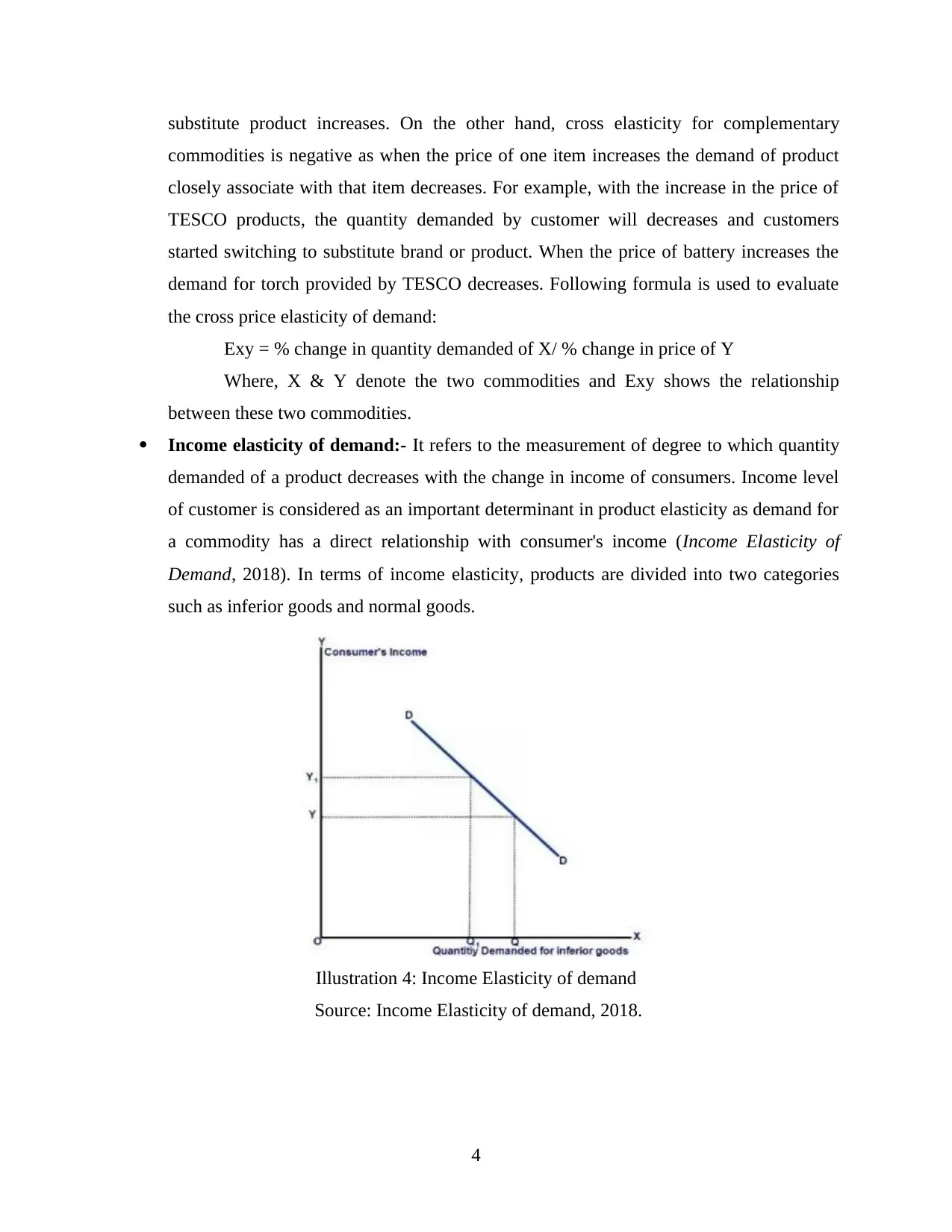
substitute product increases. On the other hand, cross elasticity for complementary
commodities is negative as when the price of one item increases the demand of product
closely associate with that item decreases. For example, with the increase in the price of
TESCO products, the quantity demanded by customer will decreases and customers
started switching to substitute brand or product. When the price of battery increases the
demand for torch provided by TESCO decreases. Following formula is used to evaluate
the cross price elasticity of demand:
Exy = % change in quantity demanded of X/ % change in price of Y
Where, X & Y denote the two commodities and Exy shows the relationship
between these two commodities.
Income elasticity of demand:- It refers to the measurement of degree to which quantity
demanded of a product decreases with the change in income of consumers. Income level
of customer is considered as an important determinant in product elasticity as demand for
a commodity has a direct relationship with consumer's income (Income Elasticity of
Demand, 2018). In terms of income elasticity, products are divided into two categories
such as inferior goods and normal goods.
Source: Income Elasticity of demand, 2018.
4
Illustration 4: Income Elasticity of demand
commodities is negative as when the price of one item increases the demand of product
closely associate with that item decreases. For example, with the increase in the price of
TESCO products, the quantity demanded by customer will decreases and customers
started switching to substitute brand or product. When the price of battery increases the
demand for torch provided by TESCO decreases. Following formula is used to evaluate
the cross price elasticity of demand:
Exy = % change in quantity demanded of X/ % change in price of Y
Where, X & Y denote the two commodities and Exy shows the relationship
between these two commodities.
Income elasticity of demand:- It refers to the measurement of degree to which quantity
demanded of a product decreases with the change in income of consumers. Income level
of customer is considered as an important determinant in product elasticity as demand for
a commodity has a direct relationship with consumer's income (Income Elasticity of
Demand, 2018). In terms of income elasticity, products are divided into two categories
such as inferior goods and normal goods.
Source: Income Elasticity of demand, 2018.
4
Illustration 4: Income Elasticity of demand
⊘ This is a preview!⊘
Do you want full access?
Subscribe today to unlock all pages.

Trusted by 1+ million students worldwide
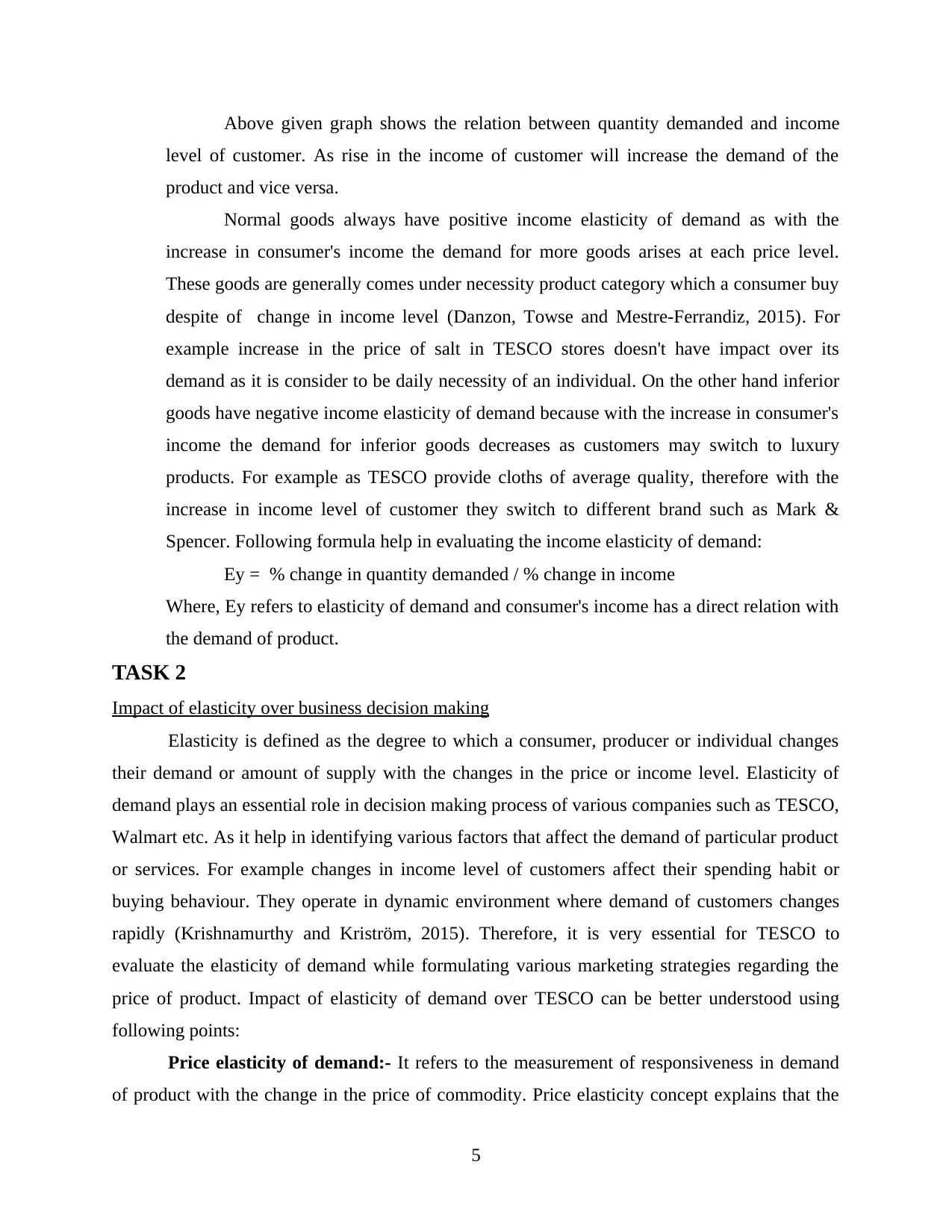
Above given graph shows the relation between quantity demanded and income
level of customer. As rise in the income of customer will increase the demand of the
product and vice versa.
Normal goods always have positive income elasticity of demand as with the
increase in consumer's income the demand for more goods arises at each price level.
These goods are generally comes under necessity product category which a consumer buy
despite of change in income level (Danzon, Towse and Mestre‐Ferrandiz, 2015). For
example increase in the price of salt in TESCO stores doesn't have impact over its
demand as it is consider to be daily necessity of an individual. On the other hand inferior
goods have negative income elasticity of demand because with the increase in consumer's
income the demand for inferior goods decreases as customers may switch to luxury
products. For example as TESCO provide cloths of average quality, therefore with the
increase in income level of customer they switch to different brand such as Mark &
Spencer. Following formula help in evaluating the income elasticity of demand:
Ey = % change in quantity demanded / % change in income
Where, Ey refers to elasticity of demand and consumer's income has a direct relation with
the demand of product.
TASK 2
Impact of elasticity over business decision making
Elasticity is defined as the degree to which a consumer, producer or individual changes
their demand or amount of supply with the changes in the price or income level. Elasticity of
demand plays an essential role in decision making process of various companies such as TESCO,
Walmart etc. As it help in identifying various factors that affect the demand of particular product
or services. For example changes in income level of customers affect their spending habit or
buying behaviour. They operate in dynamic environment where demand of customers changes
rapidly (Krishnamurthy and Kriström, 2015). Therefore, it is very essential for TESCO to
evaluate the elasticity of demand while formulating various marketing strategies regarding the
price of product. Impact of elasticity of demand over TESCO can be better understood using
following points:
Price elasticity of demand:- It refers to the measurement of responsiveness in demand
of product with the change in the price of commodity. Price elasticity concept explains that the
5
level of customer. As rise in the income of customer will increase the demand of the
product and vice versa.
Normal goods always have positive income elasticity of demand as with the
increase in consumer's income the demand for more goods arises at each price level.
These goods are generally comes under necessity product category which a consumer buy
despite of change in income level (Danzon, Towse and Mestre‐Ferrandiz, 2015). For
example increase in the price of salt in TESCO stores doesn't have impact over its
demand as it is consider to be daily necessity of an individual. On the other hand inferior
goods have negative income elasticity of demand because with the increase in consumer's
income the demand for inferior goods decreases as customers may switch to luxury
products. For example as TESCO provide cloths of average quality, therefore with the
increase in income level of customer they switch to different brand such as Mark &
Spencer. Following formula help in evaluating the income elasticity of demand:
Ey = % change in quantity demanded / % change in income
Where, Ey refers to elasticity of demand and consumer's income has a direct relation with
the demand of product.
TASK 2
Impact of elasticity over business decision making
Elasticity is defined as the degree to which a consumer, producer or individual changes
their demand or amount of supply with the changes in the price or income level. Elasticity of
demand plays an essential role in decision making process of various companies such as TESCO,
Walmart etc. As it help in identifying various factors that affect the demand of particular product
or services. For example changes in income level of customers affect their spending habit or
buying behaviour. They operate in dynamic environment where demand of customers changes
rapidly (Krishnamurthy and Kriström, 2015). Therefore, it is very essential for TESCO to
evaluate the elasticity of demand while formulating various marketing strategies regarding the
price of product. Impact of elasticity of demand over TESCO can be better understood using
following points:
Price elasticity of demand:- It refers to the measurement of responsiveness in demand
of product with the change in the price of commodity. Price elasticity concept explains that the
5
Paraphrase This Document
Need a fresh take? Get an instant paraphrase of this document with our AI Paraphraser
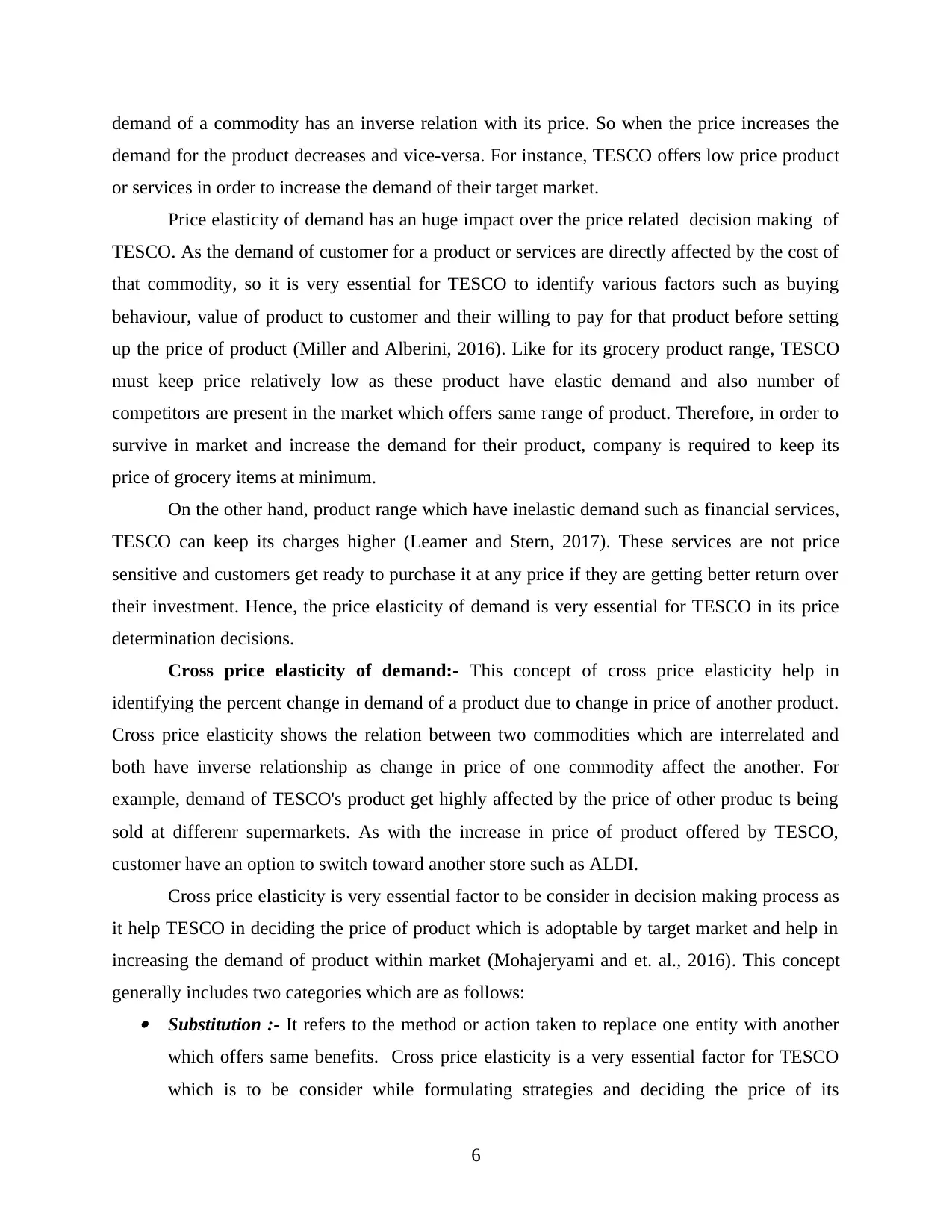
demand of a commodity has an inverse relation with its price. So when the price increases the
demand for the product decreases and vice-versa. For instance, TESCO offers low price product
or services in order to increase the demand of their target market.
Price elasticity of demand has an huge impact over the price related decision making of
TESCO. As the demand of customer for a product or services are directly affected by the cost of
that commodity, so it is very essential for TESCO to identify various factors such as buying
behaviour, value of product to customer and their willing to pay for that product before setting
up the price of product (Miller and Alberini, 2016). Like for its grocery product range, TESCO
must keep price relatively low as these product have elastic demand and also number of
competitors are present in the market which offers same range of product. Therefore, in order to
survive in market and increase the demand for their product, company is required to keep its
price of grocery items at minimum.
On the other hand, product range which have inelastic demand such as financial services,
TESCO can keep its charges higher (Leamer and Stern, 2017). These services are not price
sensitive and customers get ready to purchase it at any price if they are getting better return over
their investment. Hence, the price elasticity of demand is very essential for TESCO in its price
determination decisions.
Cross price elasticity of demand:- This concept of cross price elasticity help in
identifying the percent change in demand of a product due to change in price of another product.
Cross price elasticity shows the relation between two commodities which are interrelated and
both have inverse relationship as change in price of one commodity affect the another. For
example, demand of TESCO's product get highly affected by the price of other produc ts being
sold at differenr supermarkets. As with the increase in price of product offered by TESCO,
customer have an option to switch toward another store such as ALDI.
Cross price elasticity is very essential factor to be consider in decision making process as
it help TESCO in deciding the price of product which is adoptable by target market and help in
increasing the demand of product within market (Mohajeryami and et. al., 2016). This concept
generally includes two categories which are as follows: Substitution :- It refers to the method or action taken to replace one entity with another
which offers same benefits. Cross price elasticity is a very essential factor for TESCO
which is to be consider while formulating strategies and deciding the price of its
6
demand for the product decreases and vice-versa. For instance, TESCO offers low price product
or services in order to increase the demand of their target market.
Price elasticity of demand has an huge impact over the price related decision making of
TESCO. As the demand of customer for a product or services are directly affected by the cost of
that commodity, so it is very essential for TESCO to identify various factors such as buying
behaviour, value of product to customer and their willing to pay for that product before setting
up the price of product (Miller and Alberini, 2016). Like for its grocery product range, TESCO
must keep price relatively low as these product have elastic demand and also number of
competitors are present in the market which offers same range of product. Therefore, in order to
survive in market and increase the demand for their product, company is required to keep its
price of grocery items at minimum.
On the other hand, product range which have inelastic demand such as financial services,
TESCO can keep its charges higher (Leamer and Stern, 2017). These services are not price
sensitive and customers get ready to purchase it at any price if they are getting better return over
their investment. Hence, the price elasticity of demand is very essential for TESCO in its price
determination decisions.
Cross price elasticity of demand:- This concept of cross price elasticity help in
identifying the percent change in demand of a product due to change in price of another product.
Cross price elasticity shows the relation between two commodities which are interrelated and
both have inverse relationship as change in price of one commodity affect the another. For
example, demand of TESCO's product get highly affected by the price of other produc ts being
sold at differenr supermarkets. As with the increase in price of product offered by TESCO,
customer have an option to switch toward another store such as ALDI.
Cross price elasticity is very essential factor to be consider in decision making process as
it help TESCO in deciding the price of product which is adoptable by target market and help in
increasing the demand of product within market (Mohajeryami and et. al., 2016). This concept
generally includes two categories which are as follows: Substitution :- It refers to the method or action taken to replace one entity with another
which offers same benefits. Cross price elasticity is a very essential factor for TESCO
which is to be consider while formulating strategies and deciding the price of its
6
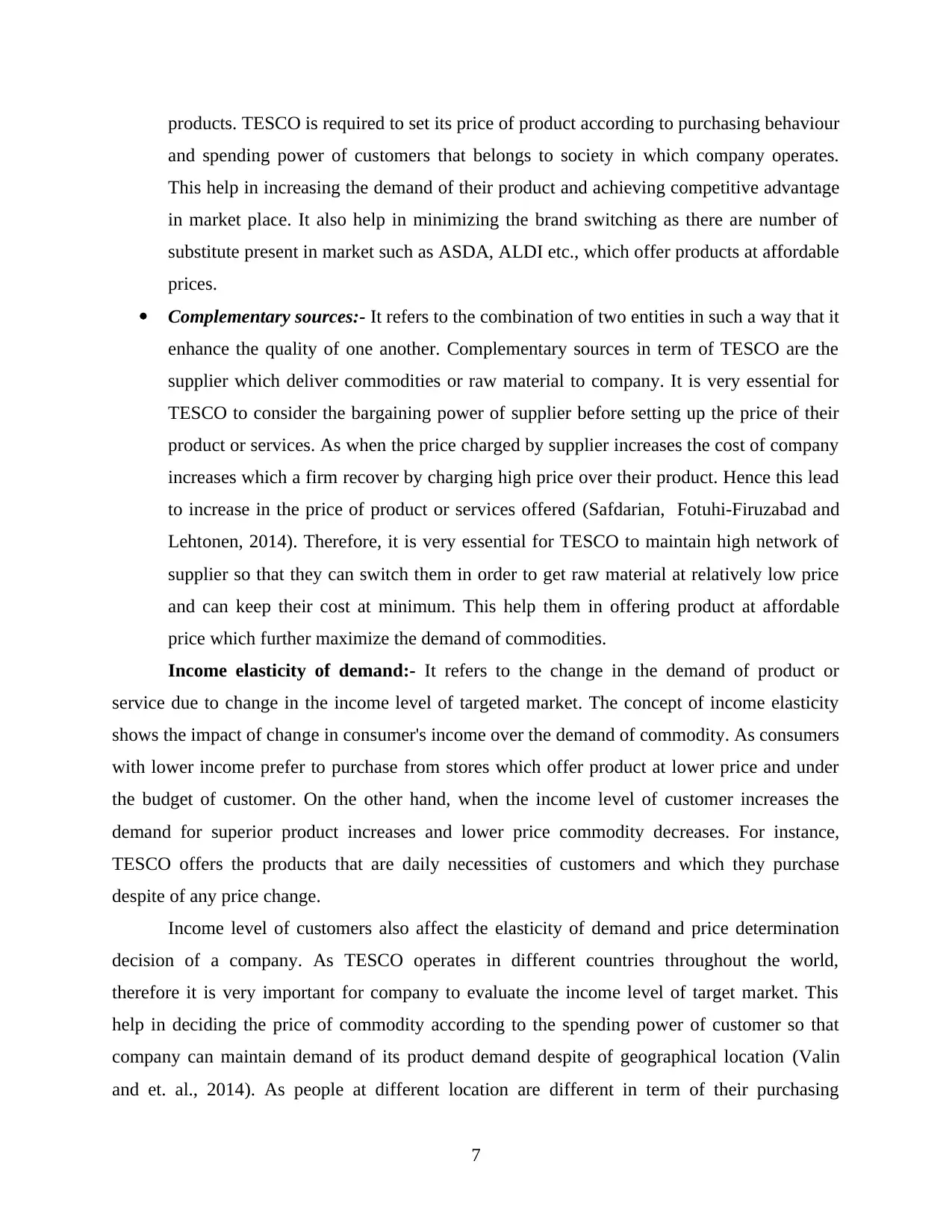
products. TESCO is required to set its price of product according to purchasing behaviour
and spending power of customers that belongs to society in which company operates.
This help in increasing the demand of their product and achieving competitive advantage
in market place. It also help in minimizing the brand switching as there are number of
substitute present in market such as ASDA, ALDI etc., which offer products at affordable
prices.
Complementary sources:- It refers to the combination of two entities in such a way that it
enhance the quality of one another. Complementary sources in term of TESCO are the
supplier which deliver commodities or raw material to company. It is very essential for
TESCO to consider the bargaining power of supplier before setting up the price of their
product or services. As when the price charged by supplier increases the cost of company
increases which a firm recover by charging high price over their product. Hence this lead
to increase in the price of product or services offered (Safdarian, Fotuhi-Firuzabad and
Lehtonen, 2014). Therefore, it is very essential for TESCO to maintain high network of
supplier so that they can switch them in order to get raw material at relatively low price
and can keep their cost at minimum. This help them in offering product at affordable
price which further maximize the demand of commodities.
Income elasticity of demand:- It refers to the change in the demand of product or
service due to change in the income level of targeted market. The concept of income elasticity
shows the impact of change in consumer's income over the demand of commodity. As consumers
with lower income prefer to purchase from stores which offer product at lower price and under
the budget of customer. On the other hand, when the income level of customer increases the
demand for superior product increases and lower price commodity decreases. For instance,
TESCO offers the products that are daily necessities of customers and which they purchase
despite of any price change.
Income level of customers also affect the elasticity of demand and price determination
decision of a company. As TESCO operates in different countries throughout the world,
therefore it is very important for company to evaluate the income level of target market. This
help in deciding the price of commodity according to the spending power of customer so that
company can maintain demand of its product demand despite of geographical location (Valin
and et. al., 2014). As people at different location are different in term of their purchasing
7
and spending power of customers that belongs to society in which company operates.
This help in increasing the demand of their product and achieving competitive advantage
in market place. It also help in minimizing the brand switching as there are number of
substitute present in market such as ASDA, ALDI etc., which offer products at affordable
prices.
Complementary sources:- It refers to the combination of two entities in such a way that it
enhance the quality of one another. Complementary sources in term of TESCO are the
supplier which deliver commodities or raw material to company. It is very essential for
TESCO to consider the bargaining power of supplier before setting up the price of their
product or services. As when the price charged by supplier increases the cost of company
increases which a firm recover by charging high price over their product. Hence this lead
to increase in the price of product or services offered (Safdarian, Fotuhi-Firuzabad and
Lehtonen, 2014). Therefore, it is very essential for TESCO to maintain high network of
supplier so that they can switch them in order to get raw material at relatively low price
and can keep their cost at minimum. This help them in offering product at affordable
price which further maximize the demand of commodities.
Income elasticity of demand:- It refers to the change in the demand of product or
service due to change in the income level of targeted market. The concept of income elasticity
shows the impact of change in consumer's income over the demand of commodity. As consumers
with lower income prefer to purchase from stores which offer product at lower price and under
the budget of customer. On the other hand, when the income level of customer increases the
demand for superior product increases and lower price commodity decreases. For instance,
TESCO offers the products that are daily necessities of customers and which they purchase
despite of any price change.
Income level of customers also affect the elasticity of demand and price determination
decision of a company. As TESCO operates in different countries throughout the world,
therefore it is very important for company to evaluate the income level of target market. This
help in deciding the price of commodity according to the spending power of customer so that
company can maintain demand of its product demand despite of geographical location (Valin
and et. al., 2014). As people at different location are different in term of their purchasing
7
⊘ This is a preview!⊘
Do you want full access?
Subscribe today to unlock all pages.

Trusted by 1+ million students worldwide
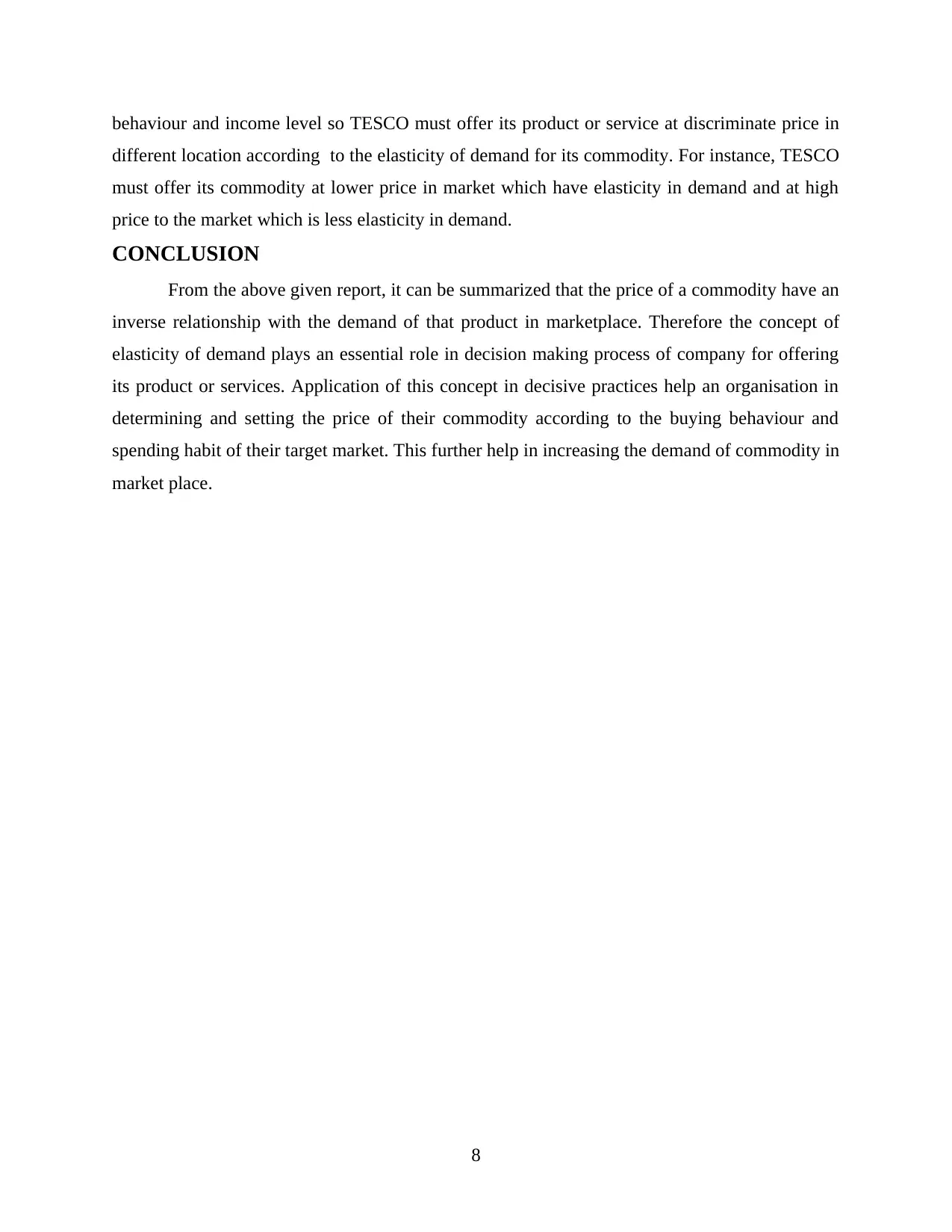
behaviour and income level so TESCO must offer its product or service at discriminate price in
different location according to the elasticity of demand for its commodity. For instance, TESCO
must offer its commodity at lower price in market which have elasticity in demand and at high
price to the market which is less elasticity in demand.
CONCLUSION
From the above given report, it can be summarized that the price of a commodity have an
inverse relationship with the demand of that product in marketplace. Therefore the concept of
elasticity of demand plays an essential role in decision making process of company for offering
its product or services. Application of this concept in decisive practices help an organisation in
determining and setting the price of their commodity according to the buying behaviour and
spending habit of their target market. This further help in increasing the demand of commodity in
market place.
8
different location according to the elasticity of demand for its commodity. For instance, TESCO
must offer its commodity at lower price in market which have elasticity in demand and at high
price to the market which is less elasticity in demand.
CONCLUSION
From the above given report, it can be summarized that the price of a commodity have an
inverse relationship with the demand of that product in marketplace. Therefore the concept of
elasticity of demand plays an essential role in decision making process of company for offering
its product or services. Application of this concept in decisive practices help an organisation in
determining and setting the price of their commodity according to the buying behaviour and
spending habit of their target market. This further help in increasing the demand of commodity in
market place.
8
Paraphrase This Document
Need a fresh take? Get an instant paraphrase of this document with our AI Paraphraser
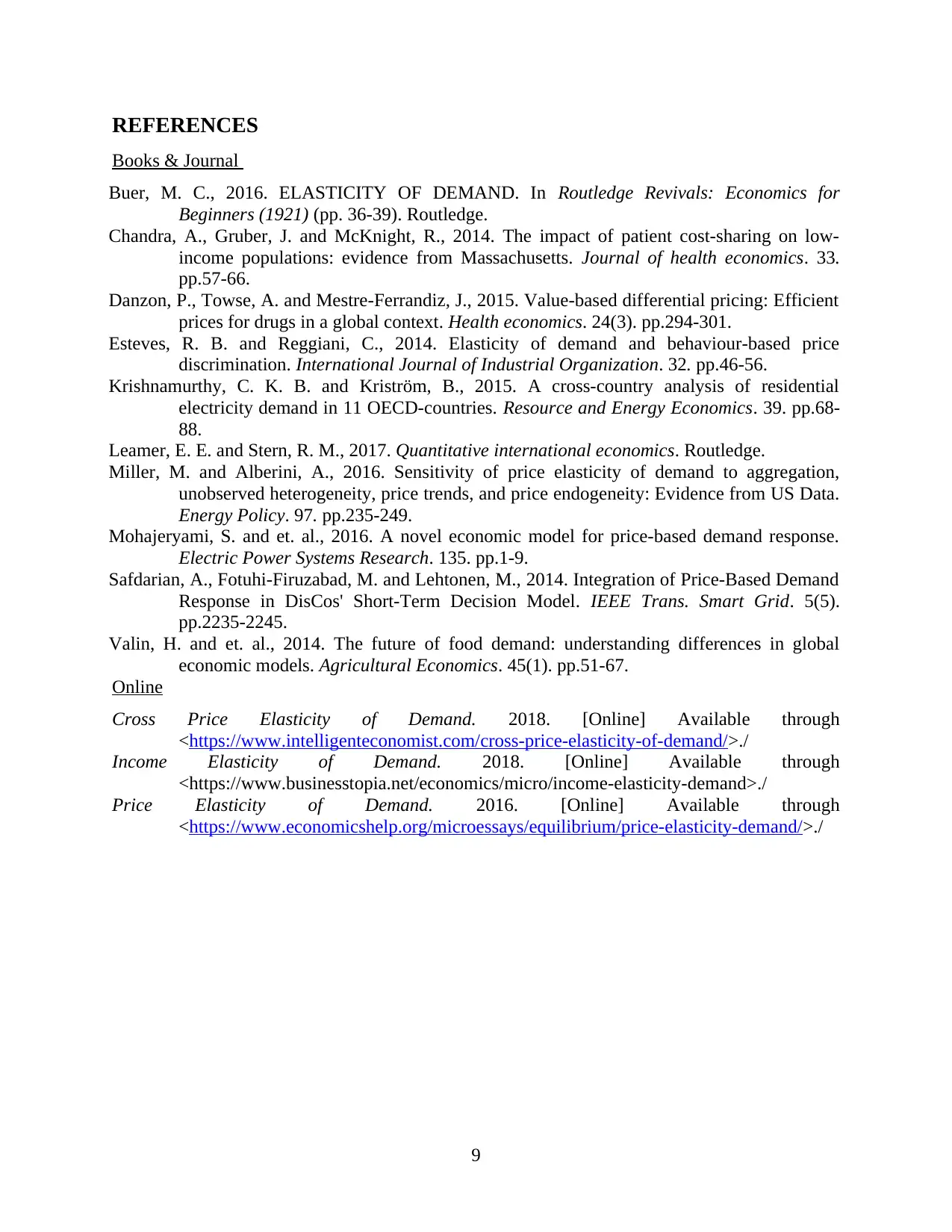
REFERENCES
Books & Journal
Buer, M. C., 2016. ELASTICITY OF DEMAND. In Routledge Revivals: Economics for
Beginners (1921) (pp. 36-39). Routledge.
Chandra, A., Gruber, J. and McKnight, R., 2014. The impact of patient cost-sharing on low-
income populations: evidence from Massachusetts. Journal of health economics. 33.
pp.57-66.
Danzon, P., Towse, A. and Mestre‐Ferrandiz, J., 2015. Value‐based differential pricing: Efficient
prices for drugs in a global context. Health economics. 24(3). pp.294-301.
Esteves, R. B. and Reggiani, C., 2014. Elasticity of demand and behaviour-based price
discrimination. International Journal of Industrial Organization. 32. pp.46-56.
Krishnamurthy, C. K. B. and Kriström, B., 2015. A cross-country analysis of residential
electricity demand in 11 OECD-countries. Resource and Energy Economics. 39. pp.68-
88.
Leamer, E. E. and Stern, R. M., 2017. Quantitative international economics. Routledge.
Miller, M. and Alberini, A., 2016. Sensitivity of price elasticity of demand to aggregation,
unobserved heterogeneity, price trends, and price endogeneity: Evidence from US Data.
Energy Policy. 97. pp.235-249.
Mohajeryami, S. and et. al., 2016. A novel economic model for price-based demand response.
Electric Power Systems Research. 135. pp.1-9.
Safdarian, A., Fotuhi-Firuzabad, M. and Lehtonen, M., 2014. Integration of Price-Based Demand
Response in DisCos' Short-Term Decision Model. IEEE Trans. Smart Grid. 5(5).
pp.2235-2245.
Valin, H. and et. al., 2014. The future of food demand: understanding differences in global
economic models. Agricultural Economics. 45(1). pp.51-67.
Online
Cross Price Elasticity of Demand. 2018. [Online] Available through
<https://www.intelligenteconomist.com/cross-price-elasticity-of-demand/>./
Income Elasticity of Demand. 2018. [Online] Available through
<https://www.businesstopia.net/economics/micro/income-elasticity-demand>./
Price Elasticity of Demand. 2016. [Online] Available through
<https://www.economicshelp.org/microessays/equilibrium/price-elasticity-demand/>./
9
Books & Journal
Buer, M. C., 2016. ELASTICITY OF DEMAND. In Routledge Revivals: Economics for
Beginners (1921) (pp. 36-39). Routledge.
Chandra, A., Gruber, J. and McKnight, R., 2014. The impact of patient cost-sharing on low-
income populations: evidence from Massachusetts. Journal of health economics. 33.
pp.57-66.
Danzon, P., Towse, A. and Mestre‐Ferrandiz, J., 2015. Value‐based differential pricing: Efficient
prices for drugs in a global context. Health economics. 24(3). pp.294-301.
Esteves, R. B. and Reggiani, C., 2014. Elasticity of demand and behaviour-based price
discrimination. International Journal of Industrial Organization. 32. pp.46-56.
Krishnamurthy, C. K. B. and Kriström, B., 2015. A cross-country analysis of residential
electricity demand in 11 OECD-countries. Resource and Energy Economics. 39. pp.68-
88.
Leamer, E. E. and Stern, R. M., 2017. Quantitative international economics. Routledge.
Miller, M. and Alberini, A., 2016. Sensitivity of price elasticity of demand to aggregation,
unobserved heterogeneity, price trends, and price endogeneity: Evidence from US Data.
Energy Policy. 97. pp.235-249.
Mohajeryami, S. and et. al., 2016. A novel economic model for price-based demand response.
Electric Power Systems Research. 135. pp.1-9.
Safdarian, A., Fotuhi-Firuzabad, M. and Lehtonen, M., 2014. Integration of Price-Based Demand
Response in DisCos' Short-Term Decision Model. IEEE Trans. Smart Grid. 5(5).
pp.2235-2245.
Valin, H. and et. al., 2014. The future of food demand: understanding differences in global
economic models. Agricultural Economics. 45(1). pp.51-67.
Online
Cross Price Elasticity of Demand. 2018. [Online] Available through
<https://www.intelligenteconomist.com/cross-price-elasticity-of-demand/>./
Income Elasticity of Demand. 2018. [Online] Available through
<https://www.businesstopia.net/economics/micro/income-elasticity-demand>./
Price Elasticity of Demand. 2016. [Online] Available through
<https://www.economicshelp.org/microessays/equilibrium/price-elasticity-demand/>./
9
1 out of 11
Related Documents
Your All-in-One AI-Powered Toolkit for Academic Success.
+13062052269
info@desklib.com
Available 24*7 on WhatsApp / Email
![[object Object]](/_next/static/media/star-bottom.7253800d.svg)
Unlock your academic potential
Copyright © 2020–2025 A2Z Services. All Rights Reserved. Developed and managed by ZUCOL.


